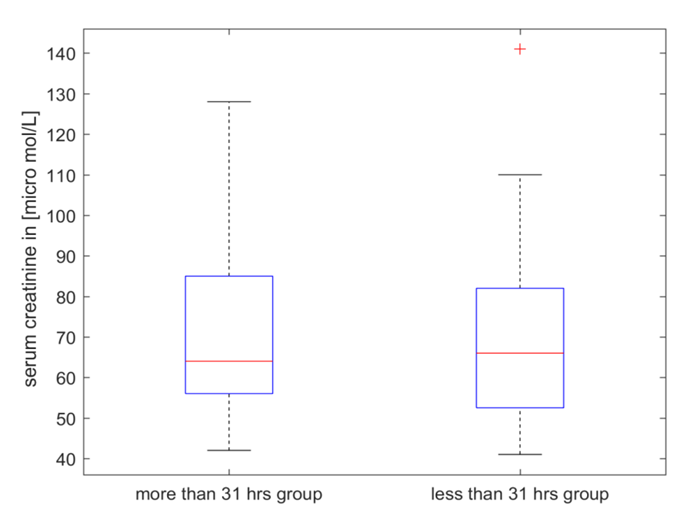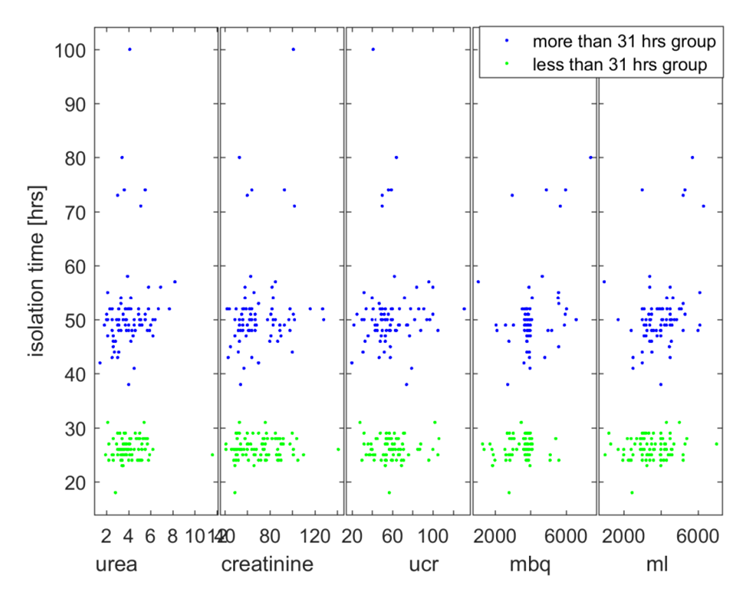-
Paper Information
- Previous Paper
- Paper Submission
-
Journal Information
- About This Journal
- Editorial Board
- Current Issue
- Archive
- Author Guidelines
- Contact Us
International Journal of Statistics and Applications
p-ISSN: 2168-5193 e-ISSN: 2168-5215
2022; 12(1): 16-22
doi:10.5923/j.statistics.20221201.03
Received: Jan. 13, 2022; Accepted: Jan. 29, 2022; Published: Feb. 15, 2022

Administered Activity and Fluids Intake as Predictors of Shorter Isolation Time for Low Risk Papillary Thyroid Cancer Patients Undergoing Radioactive Iodine Therapy
1Medical Physics department, Prince Sultan Military Medical City, Riyadh, Saudi Arabia
2Radiation Protection Consulting, Charlottetown, PEI, Canada
Correspondence to: Khaled M. Soliman, Medical Physics department, Prince Sultan Military Medical City, Riyadh, Saudi Arabia.
| Email: |  |
Copyright © 2022 The Author(s). Published by Scientific & Academic Publishing.
This work is licensed under the Creative Commons Attribution International License (CC BY).
http://creativecommons.org/licenses/by/4.0/

Objectives: Patients upon admission in the isolation ward to be treated with radioactive iodine for thyroid cancer post ablation are instructed to drink plenty of water in order to shorten the length of stay at the hospital and to be discharged in a timely manner. Methods: Logistic regression (LR) was used to analyze the multivariable data and to propose a logistic regression model (LRM) that can predict the probability of the patient to be isolated for shorter time taking into account the administered activity in [MBq] and the total volume in [ml] of fluids consumed during his stay. Results: The proposed logistic regression model is: Log (odds) = -3.9931 + 0.0007*(fluids intake in [ml]) + .0011*(administered activity in [MBq]). This model has an area under the ROC curve of 0.70 and false positive rate of 0.34 or (specificity= .66) and true positive rate or (sensitivity) of 0.68. The model may help organizing the ward assignment and allows better planed radiation protection aspects of the procedure. Conclusions: The presented method can be used to analyze variables related to a binary outcome like short or long isolation time and also to predict the probability of the outcome before the start of the procedure once we know the administered activity and the amount of fluids that the patients will consume during his or her stay in the ward.
Keywords: Papillary thyroid cancer, Radioactive Iodine treatment, Isolation time, Logistic regression model
Cite this paper: Khaled M. Soliman, Administered Activity and Fluids Intake as Predictors of Shorter Isolation Time for Low Risk Papillary Thyroid Cancer Patients Undergoing Radioactive Iodine Therapy, International Journal of Statistics and Applications, Vol. 12 No. 1, 2022, pp. 16-22. doi: 10.5923/j.statistics.20221201.03.
1. Introduction
- For thyroid cancer patients undergoing radioactive iodine therapy (RIT) the release from hospital confinement is possible when the radiation dose levels emitted from the patient are below national regulatory permissible levels or the remaining radioactive iodine in their bodies are below a certain regulatory defined amount, in the kingdom of Saudi Arabia it is 1100 MBq. Upon admission to the ward the patients are given the instructions to drink plenty of water and fluids, also to void their urinary bladder frequently in order to reduce their hospitalization time and reduce internal radiation exposure to other body organs such as the bladder and the bone marrow. It is known that radioactive iodine (RI) is eliminated from the body mainly through the urine.It has been hypothesized that renal deficiency may lead to slower iodine-131 excretion rate from the patients leading to longer isolation time in the ward [1].Renal dysfunction has been associated with larger serum creatinine values. Also serum creatinine has been used in the calculation of the estimated glomerular filtration rate (eGFR), therefore examination of the relationship between the patient serum creatinine level and shorter isolation time (IT) is kind of rational path to explore. In a recent study, it has been shown that patient using high fluid intake, more than 60 ml/hr, alone would not effectively reduce the patient's radiation dose rate at least not more than a well-hydrated state [2]. This observation suggest that there are other factors contributing to faster biological iodine release from the patients bodies and therefore a shorter IT.Another study demonstrated that patients in a hypothyroid phase of more than four weeks may have a decreased GFR and they could probably have a longer whole body effective half-life than others [3].We are interested to find out if drinking plenty of fluids is correlated with shorter IT or there might be other factors also contributing to shorten the IT. This study included a total of 218 patients, 165 females and 53 males low risk thyroid cancer patients all diagnosed with papillary thyroid carcinoma (PTC). All these patients had no distant metastases prior of being admitted to RIT.Binary logistic regression analysis method was used to analyze a number of variables that were available to us for this study namely: serum creatinine, urea, administered activity and the amount of fluids consumed during their stay in the isolation room in the ward. The results of this work have several potential implications regarding radiation protection planning and management of papillary thyroid cancer (PTC) patients treated with radioactive iodine in hospitals.For example; patients with higher probability for a long isolation time (IT) can be admitted to the ward over the weekend and the others during the week days. This will allow radiation protection staff not to be present in the hospital over the weekend to release the patients with potential longer IT period.After searching the literature and to the best of our knowledge there were a very limited number of studies relating the amount of fluids consumed by the patients and the duration of the IT in the ward for thyroid cancer patients [2,4].The aim of the study was to find predictors of short IT stay or a logistic regression model to be used to predict the duration of the isolation time, before the start of the RIT and admitting the patient into the ward.
2. Methods
- We have logged the total fluids intake for each patient in [ml] and have used this information along with other variables from the patients' files. The variables used in this analysis are: the serum urea in [µmol/L], creatinine in [mmol/L], the administered activity in [MBq] and the length of stay in [hrs]. Binary logistic regression was used to analyze the association between serum urea, creatinine, the administered activity and the amount of fluids intake with the IT. The IT was identified as the dependent variable or the outcome of the study. We had two binary outcomes described as short isolation time less than 31 hours and longer time for more than 31 hours. Table 1 has the patients' data.
|
 | (1) |
 | (2) |
 | Figure 2(a). Boxplot showing the isolation time in [hrs] for the 2 groups of isolation time in this study (n=218) patients |
 | Figure 2(b). Boxplot showing the administered activity in [MBq] distribution for the 2 groups of isolation time in this study (n=218) patients |
 | Figure 2(c). Boxplot showing the urea/creatinine ratio distribution for the 2 groups of isolation time in this study (n=218) patients |
 | Figure 2(d). Boxplot showing the creatinine distribution for the 2 groups of isolation time in this study (n=218) patients |
3. Results
- We have illustrated a method of analysis popular in both social and medical sciences research aiming at examining the relationship between multiple explanatory or independent variables and a dependent variable binary in nature. Table 2: has the result of the multivariable logistic regression analysis and the model we have found was:Log (odds) = -3.9931+ 0.0007*(fluids intake in [ml]) + .0011*(administered activity in [MBq]).
|
4. Discussion
- Logistic regression analysis found no significant correlation among urea, creatinine and urea creatinine ratio (see Table 2) and shorter isolation time in the ward or faster clearance of Iodine. This observation is in agreement with other two studies in which the authors recommend the conduct of further studies to elucidate the effect of renal insufficiency on the radioactive iodine clearance during RIT [1,5]. These studies aimed at finding a mathematical model suggesting reducing the administered activity of the radioiodine in patients with renal insufficiency. Study and review of factors influencing the thyroid cancer patients LOS during RAT has many advantages among the potential advantages, cost savings, hospital staff radiation protection, comfort of the patient and his family and better bed utilization in busy healthcare facilities.There are a number of factors affecting the biological half-live of radioiodine in papillary thyroid cancer (PTC) patient undergoing RAIT. The remaining thyroid tissue after thyroidectomy, the patient metabolic activity, the disease extent, the efficiency of the renal system and the liquid intake are among these factors [6].Metabolism of iodine in thyroid cancer patients and the associated biological elimination from their bodies are directly affecting their isolation time in the ward. Such metabolic activity is subject to many factors and biomarkers. The metabolic activity of radioactive iodine of thyroid cancer patients during RIT vary considerably among patients, the variations include the method of patient preparation before therapy administration [7-10]. Therefore finding a definitive model describing the radioiodine clearance and uptake taking into consideration the wide variability among the individual patients undergoing such therapy is a very complex task and requires further studies.Among the rare published studies aiming at the effect of fluid intake we can mention the article by (Hoe et al, 2018) They have estimated the minimum amount of fluids needed to reach the release limit in the fastest time possible was about 2103-2148 ml [4]. They also mentioned that 88.2% of their patients can be discharged by 24 hours, and 99.3% by 48 hours of isolation. This study has relatively large number of patients (218) than most of the other studies aiming to study the effective biological half-life [11-13]. The model proposed in this study needs to be tested on a larger number of patients' data for validation.
5. Conclusions
- The study helps us managing our patients admitted to the ward for RIT and enhances our radiation safety knowledge related to the local hospital environment. We have tested the possible correlations of a certain number of variables and the shortness of the length of stay of thyroid papillary thyroid cancer admitted to our medical center for RIT. Proper management of these factors will help improving the wellbeing of the patients and the bed management in the ward and the hospital in general.In this study we have shown that among the analyzed variables only the administered activity and the amount of fluids consumed during hospitalization may be the best predictors for a shorter time of stay in hospitals for papillary thyroid cancer patients treated for post thyroidectomy remnant ablation radioactive iodine therapy.
 Abstract
Abstract Reference
Reference Full-Text PDF
Full-Text PDF Full-text HTML
Full-text HTML


